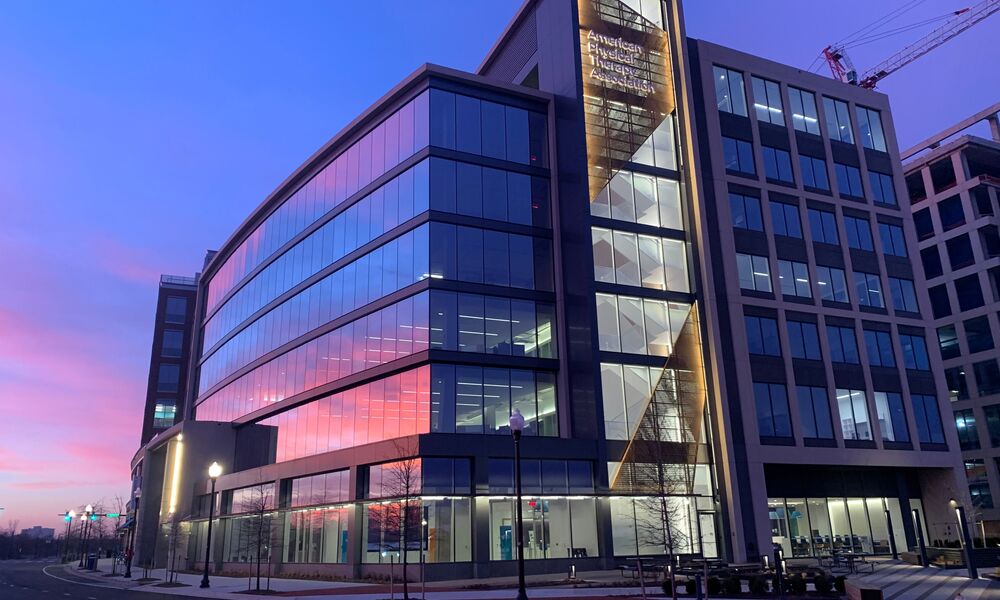
Lessons from an Association that Opened a Headquarters During a Global Pandemic
While no organization wants to finish construction on a new building during a pandemic, the American Physical Therapy Association turned this unfortunate timing into an opportunity. APTA modified its plans to ensure a building positioned to serve staff and members during this world health crisis and beyond.
While many associations have had their staff working remotely since last March and are trying to figure out how to get their building ready for return, the American Physical Therapy Association has been put in the unexpected position of finishing up its new headquarters in Alexandria, Virginia, at the height of a pandemic. However, being forced to consider how the building must function during the pandemic—as well as after it ends—has allowed APTA to shape its new headquarters with safety and flexibility in mind.
“We were fortunate when we were planning this building because we had some priorities—and they were accentuated during the pandemic,” said APTA CEO Justin Moore, PT, DPT. “We wanted to create a more flexible work environment, to give our employees the ability to work in different spaces, including remotely, and to create a facility that promoted health and wellness.”
The new building broke ground in 2019 and was timed to open January 15, 2021, coinciding with APTA’s 100th anniversary. Despite the pandemic, APTA was able to open the building earlier this month and host a hybrid ribbon-cutting ceremony.
While the building was designed to be healthy from the get-go, using LEED Silver standards and achieving Fitwel’s 3-star certification, APTA made additional changes once the pandemic hit. “We looked at air quality and the air-filtration system, open spaces that have allowed us greater social distancing, and just a way to promote health and wellness,” Moore said.
Because the building was in the interior design stage when COVID-19 related closures began last year, APTA made design changes that favored pandemic safety, including open spaces, room for sanitizing stations, and touchless access points. “If we would have been already in the building when this happened, we would have probably had to retrofit things and make other decisions,” Moore said. “Being able to be flexible in those final design stages allowed us to be more ready to operate in this type of situation.”
In addition to being health- and safety-focused, the new building was designed to host technology for distance learning and meetings. “The technology has been a huge asset for us as we’ve done this,” Moore said. “We came from a pretty old technology setup, and frankly, we were behind the times. The transition to the new facility accelerated us into a more digital-first, hybrid learning model that was a barrier to us in the past.”
In addition to serving staff, the new headquarters was intended to serve members and the community, with several meeting rooms and a conference center. While the organization does hope to generate revenue from the building, it didn’t budget any for year one, so the pandemic’s impact is lessened.
“We took a very strategic approach and did not look to have tenants or generate revenue in 2021,” Moore said. “We’re going to scale it up in 2022. Depending on how the year progresses, we still plan to activate the building in the back half of 2021, if it’s safe and we can meet guidelines. If that happens, we will accelerate our ability to leverage some of the revenue opportunities that exist in a facility of this caliber.”
Right now, APTA has brought 10 percent of its workforce to the building. Staff come in on either a Monday/Wednesday or Tuesday/Thursday schedule. “We’ve had staff say that their remote work environment isn’t working anymore, and they want to come back and utilize the workspace,” Moore said. “It’s been a voluntary process.”
For those thinking of bringing staff back, Moore has advice: take it slow. “When you bring a portion of the population back, give yourself the time to learn and get feedback from those staff and to be able to manage the issues that come up,” he said. “By going slow and starting small, we have been able to learn a lot from our staff and learn a lot about how best to operationalize a returning workforce.”
In addition, Moore said staff should have different expectations when returning to the office right now. “I think the biggest takeaway is, it’s not normal office work,” Moore said. “Even though we’re in the office, we’re still using technology a lot. When I have a meeting with somebody else in the office, primarily we’re doing it through Teams or Zoom. Those opportunities to brainstorm and get groups together to really think out new ideas is more limited than we anticipated.”
What plans are your organization making for returning to the office? Share in the comments.
(APTA)






Comments